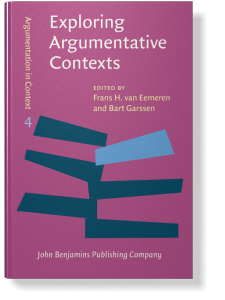Exploring Argumentative Contexts
Editors
In Exploring Argumentative Contexts Frans H. van Eemeren and Bart Garssen bring together a broad variety of essays examining argumentation as it occurs in seven communicative domains: the political context, the historical context, the legal context, the academic context, the medical context, the media context, and the financial context. These essays are written by an international group of argumentation scholars, consisting of Corina Andone, Sarah Bigi, Robert T. Craig, Justin Eckstein, Frans H. van Eemeren, Norman Fairclough, Eveline Feteris, Gerd Fritz, Bart Garssen, Kara Gilbert, Thomas Gloning, G. Thomas Goodnight, Dale A. Herbeck, Darrin Hicks, Thomas Hollihan, Jos Hornikx, Isabela Ieţcu-Fairclough, Gábor Kutrovátz, Maurizio Manzin, Davide Mazzi, Dima Mohammed, Rudi Palmieri, Angela G. Ray, Patricia Riley, Robert C. Rowland, Peter Schulz, Karen Tracy, and Gergana Zlatkova.
[Argumentation in Context, 4] 2012. xx, 398 pp.
Publishing status:
© John Benjamins Publishing Company
Table of Contents
-
List of contributors | pp. ix–xii
-
IntroductionFrans H. van Eemeren and Bart Garssen | pp. xiii–xx
-
Part I. Political context
-
Chapter 1. The reasonableness of confrontational strategic maneuvering in political interviewsCorina Andone | pp. 1–22
-
Chapter 2. Values as premises in practical arguments: Conceptions of justice in the public debate over bankers’ bonusesIsabela Fairclough and Norman Fairclough | pp. 23–42
-
Chapter 3. Exploiting the room for strategic maneuvering in argumentative discourse: Dealing with audience demand in the European ParliamentFrans H. van Eemeren and Bart Garssen | pp. 43–58
-
Chapter 4. Strategic communication: How governments frame arguments in the mediaPatricia Riley and Thomas A. Hollihan | pp. 59–78
-
Chapter 5. Arguments about ‘rhetoric’ in the 2008 US presidential election campaignRobert T. Craig | pp. 79–94
-
Part II. Historical context
-
Chapter 6. Making history by analogy: Frederick Douglass remembers William the SilentAngela G. Ray | pp. 95–114
-
Chapter 7. Analogy in history: A corpus-based studyDavide Mazzi | pp. 115–134
-
Part III. Legal context
-
Chapter 8. A rhetorical approach to legal reasoning: The Italian experience of CERMEGMaurizio Manzin | pp. 135–148
-
Chapter 9. Strategic manoeuvring in the case of the ‘Unworthy spouse’Eveline T. Feteris | pp. 149–164
-
Chapter 10. Everyday argument strategies in Appellate Court argument about same-sex marriageKaren Tracy | pp. 165–178
-
Chapter 11. Student speech in public schools: A case study in definitional argumentDale A. Herbeck | pp. 179–194
-
Part IV. Academic context
-
Chapter 12. Expert authority and ad verecundiam argumentsGábor Kutrovátz | pp. 195–212
-
Chapter 13. Critique and controversy in digital scientific communication: New formats and their affordancesGerd Fritz and Thomas Gloning | pp. 213–232
-
Part V. Medical context
-
Chapter 14. Drug advertising and clinical practice: Positing biopolitics in clinical communicationG. Thomas Goodnight and Kara Gilbert | pp. 233–254
-
Chapter 15. Argumentative insights for the analysis of direct-to-consumer advertisingDima Mohammed and Peter J. Schulz | pp. 255–268
-
Chapter 16. The battle for health care reform and the liberal public sphereRobert C. Rowland | pp. 269–288
-
Chapter 17. Contextual constraints on argumentation: The case of the medical encounterSarah Bigi | pp. 289–304
-
Part VI. Media context
-
Chapter 18. The effects of hedges and pledges in advertisements for high and low reputation brandsJos Hornikx | pp. 305–320
-
Chapter 19. Higher-order strategic maneuvering by shifting standards of reasonableness in cold-war editorial argumentationDarrin Hicks and Justin Eckstein | pp. 321–340
-
Part VII. Financial context
-
Chapter 20. The diversifying of contextual constraints and argumentative strategies in friendly and hostile takeover bidsRudi Palmieri | pp. 341–376
-
Chapter 21. Reported argumentation in economic-financial newsGergana Zlatkova | pp. 377–392
-
Name index | pp. 393–396
-
Subject index | pp. 397–398
“I would highly recommend it to students or researchers interested in argumentation research in different fields.”
Haipeng Hu, Ningbo Institute of Technology, Zhejiang University, in Discourse Studies Vol.16:5 (2014), pp. 699-701
“
Exploring Argumentative Contexts constitutes an evident proof of the growing attention of argumentation scholars to the context where arguments are applied.”
Eddo Rigotti, Università della Svizzera italiana, in Journal of Argumentation in Context Vol. 3:2 (2014), pp. 199-218
Cited by (8)
Cited by eight other publications
Kuang, Shuxiao, Jan Orbie & Sira Blancquaert
Mehltretter Drury, Jeffrey, Nicholas Paliewicz & Sara Mehltretter Drury
Oswald, Steve, Thierry Herman & Jérôme Jacquin
Gâţă, Anca
2017. Chapter 17. Strategic maneuvering with presentational choices in Corporate Social Responsibility (CSR) reports. In Contextualizing Pragma-Dialectics [Argumentation in Context, 12], ► pp. 309 ff. 
Palmieri, Rudi
2017. Frans H. van Eemeren and Bart Garssen (Eds.) (2015). Scrutinizing Argumentation in Practice
. Journal of Argumentation in Context 6:2 ► pp. 247 ff. 
Tseronis, Assimakis & Charles Forceville
2017. Introduction. Argumentation and rhetoric in visual and multimodal communication. In Multimodal Argumentation and Rhetoric in Media Genres [Argumentation in Context, 14], ► pp. 2 ff. 
van Eemeren, Frans H.
[no author supplied]
This list is based on CrossRef data as of 14 july 2024. Please note that it may not be complete. Sources presented here have been supplied by the respective publishers. Any errors therein should be reported to them.
Subjects
Communication Studies
Philosophy
Main BIC Subject
CFA: Philosophy of language
Main BISAC Subject
LAN015000: LANGUAGE ARTS & DISCIPLINES / Rhetoric
